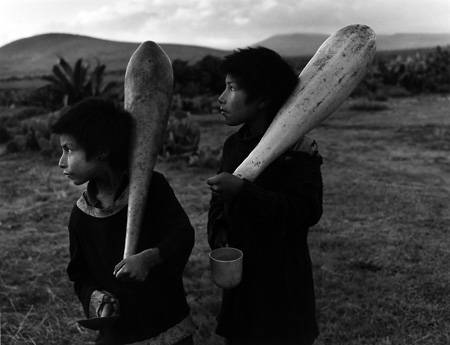


Kings of Cane / Reyes de cana by Flor Garduño
SPRING 2000
EL OJO FINO: The Exquisite Eye
SOUTHWESTERN & MEXICAN PHOTOGRAPHY COLLECTION
El Ojo Fino / The Exquisite Eye features the photography of great women photographers of Mexico. Included in the exhibit are works by Maya Goded, Graciela Iturbide, Mariana Yampolsky, Lola Alvarez Bravo, Yolanda Andrade, Flor Garduño, Kati Horna, Ángeles Torrejón, and Alicia Ahumada. There are a total of 48 prints in the exhibit.
El Ojo Fino / The Exquisite Eye features the works of nine great women photographers of Mexico. They are artists from three generations who have literally joined hands and hearts to reach across the 20th century and confront with us the essential stuff of life: Lola Álvarez Bravo, Kati Horna, Mariana Yampolsky, Graciela Iturbide, Flor Garduño, Yolanda Andrade, Alicia Ahumada, Ángeles Torrejón, and Maya Goded. They are, or have been, friends and acquaintances—although Lola has now passed away and Kati lives a secluded life. With one exception, they all live in or near Mexico City. Their images have extensive aesthetic connections—little homages here and there, borrowed elements, overlapping spiritual territory, similar styles.
Lola Álvarez Bravo was the first—she was probably the most prominent of the first generation of women photographers in Mexico and--inspired by Tina Modotti--one of the very first to earn a living through photography. Next is Hungarian-born Kati Horna who came to Mexico in the late 1930s with her husband after the defeat of the Republican forces in the Spanish Civil War. Although she always denied being a surrealist, she soon fell in with their group and met Lola Bravo. They both became influential teachers, Lola for decades as director of the Photography Department of Bellas Artes in Mexico City and Kati as a teacher and mentor.
In the late 1940s, Mariana Yampolsky, another immigrant—but this time from the US—arrived in Mexico City, fresh from the University of Chicago. She headed straight for the Popular Graphic Arts Workshop, became an engraver there and a member of that great fellowship of artists. When she considered taking up photography as a discipline she chose Lola Bravo as her first teacher, and they remained close friends until Lola’s death in 1993.
Later on, in the 60s, Mariana and Manuel Álvarez Bravo--first husband of Lola-- were mentors to Graciela Iturbide. Kati Horna in her turn was mentor to Flor Garduño in the late 70s and 80s as were Yampolsky and don Manuel. Alicia Ahumada, the great printer and photographic craftsman (now beginning to work full time on her own images) became printer for both Yampolsky and Iturbide, learning from them as she made their prints, and of course, greatly influenced by them both.
Yolanda Andrade was born in Mexico and studied photography in Rochester, New York at the Visual Studies Workshop and State University of New York. Pedro Meyer was her mentor, and Andrade became friends with his then-wife, Graciela Iturbide and later on, with Mariana Yampolsky. Since the great earthquake in 1984, her work has primarily concentrated on documenting the street life of Mexico City.
Ángeles Torrejón is friend and colleague to the entire group and well known to them as the director of Imagenlatina, a news agency which provides photographic images to magazines and newspapers worldwide. Her photography, although much impacted by the photojournalism of her brilliant husband, Marco Antonio Cruz, has its own distinctive angle. She travels regularly to Chiapas, and has entree to photograph the daily life of the Zapatista National Liberation Army and the daily life of the Indian sympathizers in Zapatista territory, focusing primarily on women and children, including their flights into the jungle when pursued by Mexican Federal forces. She has recently published a book of these images, Imágenes de la realidad, financed through grants from FONCA and CONACULTA.
Maya Goded, born c. 1970, is the youngest of the nine and a protegee of Graciela Iturbide. She, like Iturbide and Yampolsky and Torrejón, has worked with specific tribal groups of indigenous women. Later, however, she branched out to create a photographic series on prostitutes in Mexico City, and she has currently turned her lens on the city’s ubiquitous "salones de belleza"—beauty shops.
Each woman is a strong artist in her own right, with a body of work well able to stand alone. Turning a fearless gaze on Mexico, they are, in the best sense of that task, each preservers and carriers of culture down through the generations; and together they are a formidable sisterhood and a Mexican voice that will speak with universal resonance to everyone who will listen.
- Facebook
- Twitter
- Instagram
- Youtube
Email List